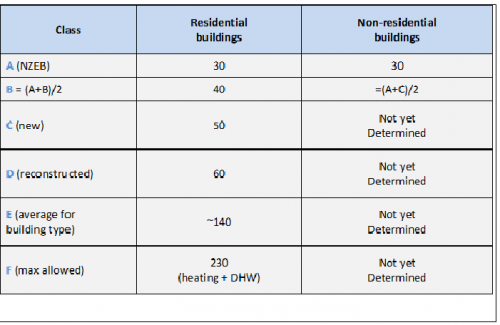EPBD in Latvia
EPBD in Latvia
The implementation of the EPBD in Latvia (responsible the Ministry of Economics). The transposition of the EPBD recast (2010/31/EC) partly adopted by mid of 2013.
Law on Energy Performance of Buildings (from 9 January 2013) was adopted by the Saeima of the Republic of Latvia, based on the requirements set forth by Directive 2010/31/EU regarding energy certification of buildings and “nearly zero-energy buildings”; its aim is to facilitate rational use of energy sources by improving energy efficiency of buildings, as well as to inform the general public about energy consumption of buildings. The law defines term “nearly zero-energy building — a building with a very high energy performance using high efficiency systems for the energy supply thereof”. According to Section 15 of the Law, the general supervision and coordination of the energy performance of buildings shall be performed by the Ministry of Economics, which shall: “..4) perform measures which promote the renovation of buildings or the construction of low or nearly zero-energy buildings; 5) perform measures so that users are provided with recommendations in respect of inspection of heating systems and air conditioning systems and improvement of the performance thereof..”
Legal acts issued basing on the Law on Energy Performance of Buildings:
Cabinet Regulation No. 383 Regulations regarding Energy Certification of Buildings (Riga, 9 July 2013 (minutes No. 39, § 39)), which stipulates the classification system for energy certification of buildings and requirements for nearly zero-energy buildings:
Energy efficiency classes for residential buildings:
Class A — conforms to the requirements for nearly zero-energy buildings;
Class B — energy efficiency index for heating does not exceed 40 kWh/m2 per year;
Class B — energy efficiency index for heating does not exceed 50 kWh/m2 per year;
Class B — energy efficiency index for heating does not exceed 60 kWh/m2 per year;
Class E — conforms to the average consumption of buildings of the particular type;
Class F — conforms to the permissible level of energy consumption set in national legislation regarding management of residential buildings.
Energy performance scale (compare heating consumption)1 kWh/m2 per year
A building shall be classified as nearly zero-energy building if it conforms to all the following requirements:
energy consumption for heating accounts to not more than 30 kWh/1 m2 per year and ensures conformity of the micro-climate in building to the requirements of national legislation in the field of construction, hygiene, and occupational safety at the same time;
total consumption of primary energy for heating, hot water supply, mechanical ventilation, cooling, and lighting accounts to not more than 95 kWh/1 m2 per year;
high efficiency systems are in use in the building that:
provide for recovery of minimum 75% ventilation heat during heating season;
provide for at least partial use of renewable energy;
no low-performance fossil fuel heating equipment have been installed in the building.
Cabinet Regulation No. 382 Regulations regarding Independent Experts in the Field of Energy Efficiency of Buildings
(Riga, 9 July 2013 (minutes No. 39, § 32)), which determines requirements for independent expert competence and procedure for competence approving, procedure for registration and supervision of independent expert, as well as content of independent expert register data and procedure for use thereof.
Cabinet Regulation No. 348 Calculation Method of Building Energy Efficiency (Riga, 25 June 2013 (minutes No. 36, § 27)) sets forth a method for calculating energy efficiency of building, which is used for drafting balance at the building level, and determines the engineering systems to be included in the appraisal of building energy efficiency, as well as limits and types of appraisal. Laws and regulations adopted in 2013 in the field of NZEB and energy efficiency neither determine and nor provide for standards for Passive Houses; however, they form legal basis for further measures. In Latvia, the maximum defined energy consumption for providing heat in NZEB is 30 kWh/m2 per year, which is twice as big as the Passive House Standard — 15 kWh/m2 per year. State support and interest are necessary in the monitoring of current situation related to energy consumption in buildings in form of accounting of both consumed energy for providing heat for building (measured in kWh/m2 per year) and carbon dioxide emission (measured in kg CO2/m2 per year).
In Latvia, more should be done for applying the national Passive House Standard with data characteristic of the Latvian climate, since our maritime climate is favourable with milder temperature in winter close to calculation of German standard climate. But energy consumption of a similar building in Daugavpils will be larger by approximately 10–25 kWh/m2 per year.
